Chapter: 11th Botany : Chapter 9 : Tissue and Tissue System
Simple Permanent Tissues: Parenchyma, Collenchyma, Sclerenchyma
The Permanent tissues develop from apical meristem. They lose the power of cell division either permanently or temporarily. They are classified into two types:
1. Simple permanent tissues.
2. Complex permanent tissues.
Simple Permanent
Tissues
Simple tissues are composed of one type of cells only. The cells are structurally and functionally similar. It is of three types.
1. Parenchyma
2. Collenchyma
3. Sclerenchyma
1. Parenchyma (Gk: Para-beside; enehein- to pour)
Parenchyma is generally present in all
organs of the plant. It forms the
ground tissue in a plant. Parenchyma is a living tissue and made up of thin
walled cells. The cell wall is made up of cellulose. Parenchyma cells may be
oval, polyhedral, cylindrical, irregular, elongated or armed. Parenchyma tissue
normally has prominent intercellular spaces. Parenchyma may store various types
of materials like, water, air, ergastic substances. It is usually colourless.
The turgid parenchyma cells help in giving rigidity to the plant body. Partial
conduction of water is also maintained through parenchymatous cells.
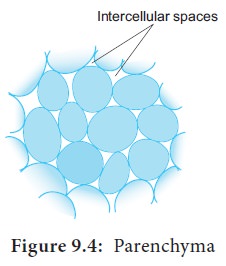
Occsionally
Parenchyma cells which store resin, tannins, crystals of calcium carbonate,
calcium oxalate are called idioblasts. Parenchyma is of different types and
some of them are discussed as follows.
Types of Parenchyma
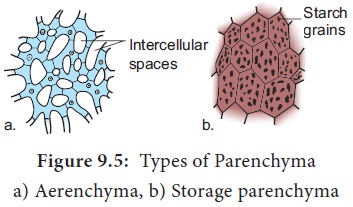
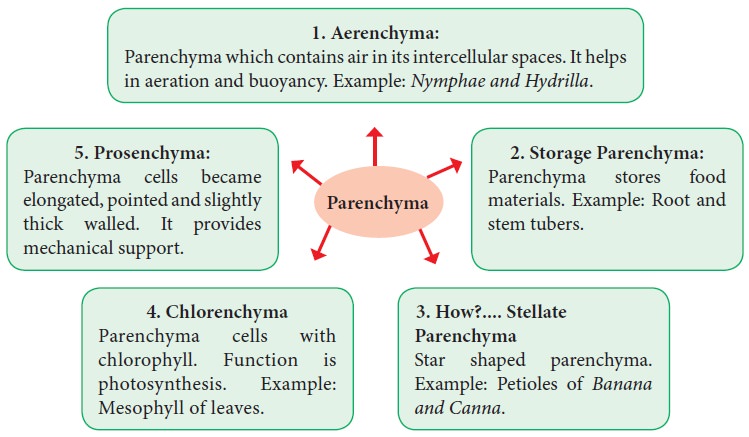
2. Collenchyma (Gk. Colla-glue; enchyma – an infusion)
Collenchyma
is a simple, living mechanical tissue. Collenchyma generally occurs in
hypodermis of dicot stem. It is absent in the roots and also occurs in petioles
and pedicels. The cells are elongated and appear polygonal in cross section.
The cell wall is unevenly thickened. It contains more of hemicellulose and
pectin besides cellulose. It provides mechanical support and elasticity to the
growing parts of the plant. Collenchyma consists of narrow cells. It has only a
few small chloroplast or none. Tannin maybe present in collenchyma.Based on
pattern of pectinisation of the cell wall, there are three types of
collenchymas.
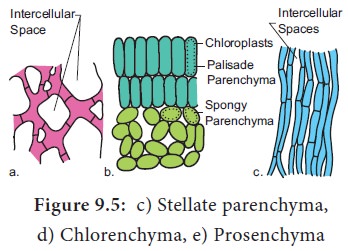
Types of Collenchyma
1. Angular collenchyma
It is the
most common type of collenchyma with irregular arrangement and thickening at
the angles where cells meets. Example:Hypodermis of Datura and Nicotiana
2. Lacunar collenchyma
The
collenchyma cells are irregularly arranged. Cell wall is thickening on the
walls bordering intercellular spaces. Example:Hypodermis of Ipomoea
3. Lamellar collenchyma
The
collenchyma cells are arranged compactly in layers(rows). The Cell wall is
thickening is at tangential walls.These thickening appear as successsive
tangential layers. Example:Hypodermis of Helianthus
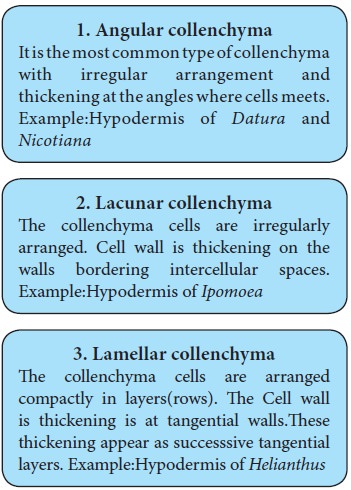
Diagramatic structures

Annular Collenchyma: Duchaigne (1955) reported
another type called Annular collenchyma in petiole of Nerium. The lumen is more
or less circular in shape.
3. Sclerenchyma (Gk. Sclerous- hard: enchyma-an
infusion)
The sclerenchyma is dead cell and lacks protoplasm. The cells are long or short, narrow thick walled and lignified secondary walls. The cell walls of these cells are uniformly and strongly thickened. The sclerenchymatous cells are of two types:
1. Sclereids
2. Fibres
Sclereids (Stone Cells)
Sclereids
are dead cells, usually these are isodiametric but some are elongated too. The
cell wall is very thick due to lignification. Lumen is very much reduced. The
pits may simple or branched. Sclereids are mechanical in function. They give
hard texture to the seed coats, endosperms etc., Sclereids are classified into
the following types.
Types of Sclereids
1. Branchysclereids or Stone cells:
Isodiametric
sclereids, with hard cell wall. It is found in bark, pith cortex, hard
endosperm and fleshy portion of some fruits. Example: - Pulp of Pyrus.
2. Macrosclereids:
Elongated
and rod shaped cells, found in the outer seed coat of leguminous plants.
Example: Crotalaria and Pisum sativum.
3. Osteosclereids (Bone cells):
Rod
shaped with dilated ends. They occur in leaves and seed coats. Example: seed
coat of Pisum and Hakea
4. Astrosclereids:
Star
cells with lobes or arms diverging form a central body. They occur in petioles
and leaves. Example: Tea, Nymphae and
Trochodendron.
5. Trichosclereids:
Hair like
thin walled sclereids. Numerous small angular crystals are embedded in the wall
of these sclereids, present in stems and leaves of hydrophytes. Example: Nymphaea leaf and Aerial roots of
Monstera.
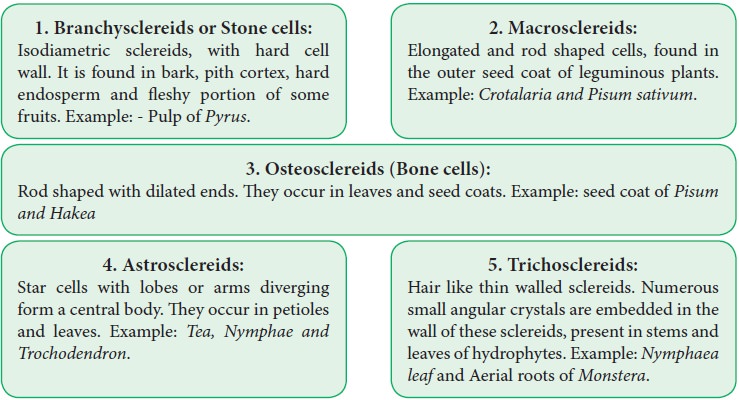
Filiform Sclereids: The sclereids are
present in the leaf lamina of Olea europaea. They are very much elongated fibre
like and about 1m.m length.
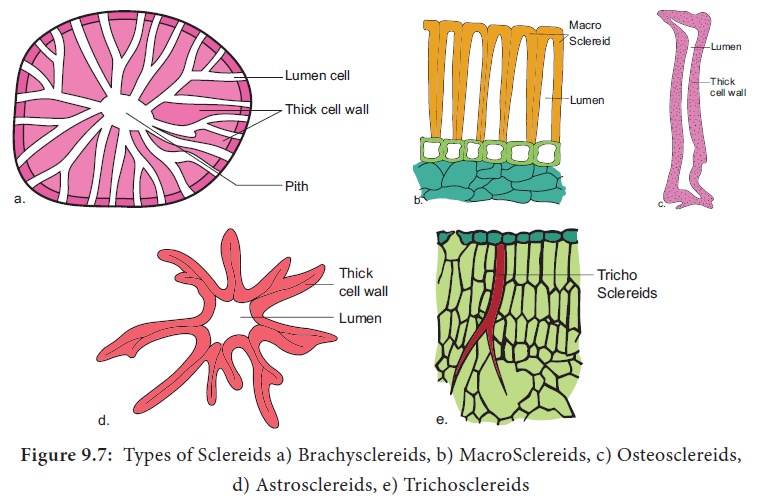
Sclerenchyma Found in Some Fruits

Fibres
Fibres
are very much elongated sclerenchyma cells with pointed tips. Fibres are dead
cells and have lignified walls with narrow lumen. They have simple pits. They
provide mechanical strength and protect them from the strong wind. It is also
called supporting tissues. Fibres have a great commercial value in cottage and
textile industries.

Fibres are of five types
Wood Fibres or Xylary Fibres
These
fibres are associated with the secondary xylem tissue. They are also called
xylary fibres. These fibres are derived from the vascular cambium. These are of
four types.
a.
Libriform fibres b. Fibre tracheids c. Septate fibres d. Gelatinous fibres.
a. Libriform
fibres: These fibres have slightly
lignified secondary walls with simple pits. These fibres are long and narrow.
b. Fibre tracheids: These are shorter than the libriform fibres with
moderate secondary thickenings in the cell walls. Pits are simple or bordered.
c. Septate fibres: Fibres
that have thin septa separating the
lumen into distinct chambers. Eg. Teak
d. Gelatinous fibres: Fibres in
which lignin is less in amount and
cellulose is more in this cell walls.
These
fibres are characteristic of tension wood which is formed in the underside of
leaning stems and branches.
Bastfibres or Extra Xylary Fibres
These
fibres are present in the phloem. Natural Bast fibres are strong and
cellulosic. Fibres obtaining from the phloem or outer bark of jute, kenaf, flax
and hemp plants. The so called pericyclic fibres are actually phloem fibres.
Surface Fibres
These
fibres are produced from the surface of the plant organs. Cotton and silk
cotton are the examples.They occur in the testa of seeds.
Mesocarp Fibres
![]()
Fibres
obtained from the mesocarp of drupes like Coconut.
Leaf Fibres
Fibres
obtained from the leaf of Musa, Agave and Sensciveria.
Fibres in Our Daily Life
Economically
fibres may be grouped as follows
1) Textile Fibres: Fibres utilized for the manufacture of fabrics, netting and
cordage etc.
a)
Surface
Fibres: Example: Cotton.
b)
Soft
Fibres: Example: Flax, Jute and Ramie
c)
Hard
fibres: Example: Sisal, Coconut,
Pineapple, Abaca etc.
2) Brush fibre: Fibres utilized for the manufacture of brushes and brooms.
3) Rough weaving fibres: Fibres
utilized in making baskets, chairs,
mats etc.
4) Paper making fibres: Wood
fibres utilized for paper making.
5) Filling fibres: Fibres used for stuffing cushions, mattresses, pillows,
furniture etc. Example: Bombax and
Silk cotton.
Related Topics